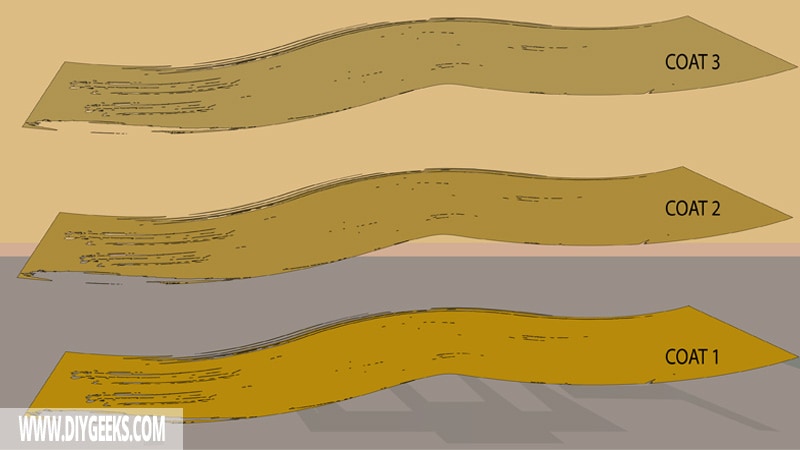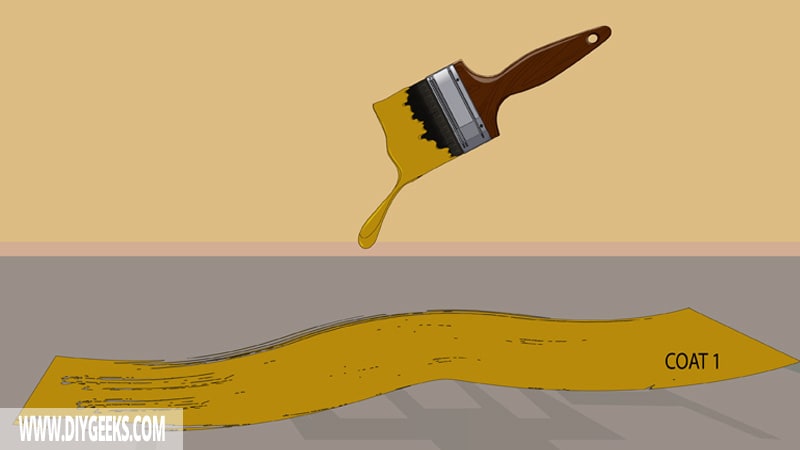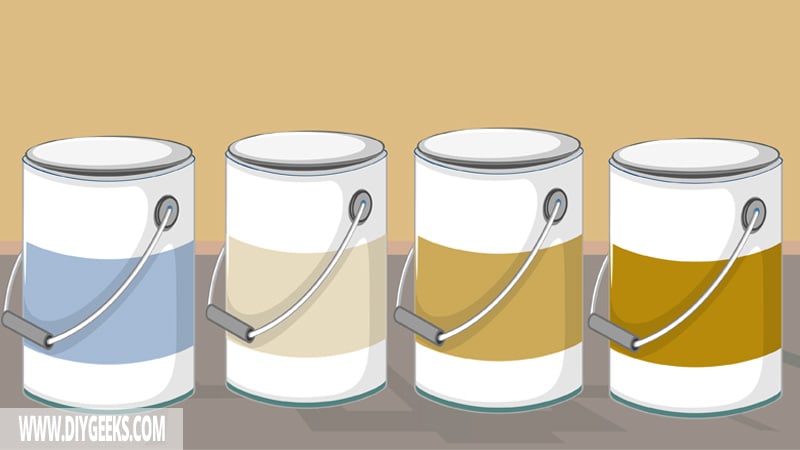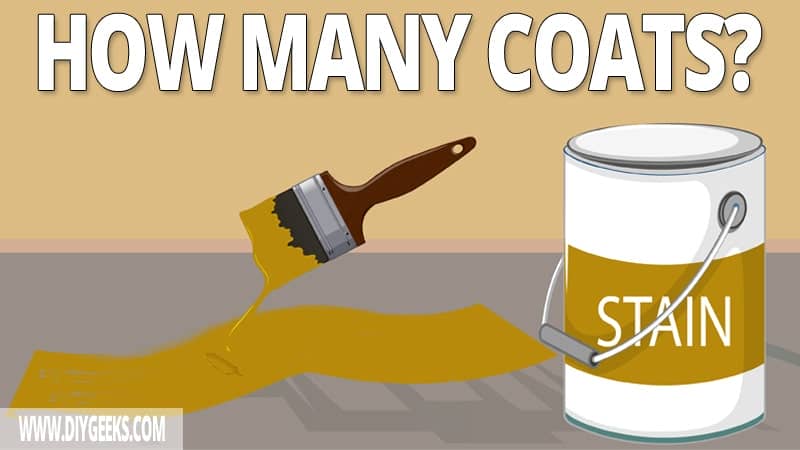The number of coats for wood stain refers to the quantity of layers you must apply to achieve the desired color, coverage, and protection.
You need two (2) wood coats for most surfaces. Wood stain penetrates a surface to stick, so you can only apply as much as the material can absorb.
Most surfaces (or materials) such as wood can only absorb 2 (two) wood stain coats. Three (3) coats will be too much for most types of wood as you need to wipe off the excess. However, some types of surfaces require more than 3 coats, such as hardwood floors.
Why Does The Number Of Wood Stain Coats Matter?

The number of wood stain coats matters as it determines the quality, durability, and coverage of the finish.
The finish will be bright, durable, and properly cover a surface if you add enough coats. But, the vibrancy will be dull, the finish won’t be durable and it won’t properly cover a surface if you don’t add enough coatings.
Wood stains are designed to penetrate the pores and cover the entire surface. But, if you don’t use enough coatings, most of the surface won’t be covered.
Wood stain protects wood from dust, debris, and handling only. So, adding fewer coatings will expose the wood to these elements.
Adding too many coats isn’t good either as it can cause waste and a sticky finish. After applying the wood stain, wipe off the excess to prevent a sticky or tacky finish.
When to Apply the Second Wood Stain Coat?

You’ll need a second wood stain when you notice any of these:
- First Coat Looks Dull – Stain is used to tint or change the entire color of a material. This means that it has a very deep color shade. So if the first coat looks dull or faded, you’ll need to add another one to improve the vibrancy and color shade.
- Protection – If you want proper protection, you need to apply two coats as only one isn’t enough.
- Sealing – You need to apply 2-3 coats if you want to seal the surface afterward. Adding just one isn’t enough as the cracks and holes won’t be covered (filled).
- Outdoors – For outdoor surfaces, you must apply more wood stains to get proper coverage. That’s because the finish will be exposed to weather elements that can damage it.
- Streaky – If the finish is looking streaky, add more stain on the surface.
- Existing Finish – If there’s an existing finish, you must apply more coats to cover it and prevent bleed-through.
- Patched Surface – For repaired or patched material, you need to apply at least two coats of stain. This is because there will be marks and imperfections on the surface that need to be covered.
What Happens if You Don’t Apply Enough Wood Stain Coats?
If you don’t apply enough wood stain coats, the surface won’t get properly covered, the finish will be weak, dull, and streaky.
Since wood stain penetrates a surface deeply to adhere, applying fewer coats of it means most of the surface will be left uncovered and the finish will be weak. The first coat of stain soaks deeply into the wood, so you need 2-3 more coats to create a layer over the surface.
The finish will have a dull and streaky appearance as fewer coatings mean the pigments won’t be over the top of the surface. The streaks in the finish will appear because there isn’t enough stain to hide imperfections.
What Happens if You Apply Too Many Wood Stain Coats?
If you apply too many wood stain coats, the finish will be streaky, and sticky, remain wet for too long, or peel off.
Too many coats means too much stain will be over the surface, creating a streaky appearance. The color will be blotchy because some parts will penetrate the surface deeper while some won’t, making the finish appear uneven.
Applying too many wood stain coats will lead to a longer dry time and wastage. The more coats you apply, the longer the stain will take to dry since the solvent will take longer to evaporate.
Also, you must remove the excess stain from the surface after you apply it. If you apply too many of it, you must wipe most of it, leading to wastage.
How Many Coats For Different Wood Stain Types?

The number of coats for different wood stain types is listed below.
Gel Stain
You need two (2) gel stain coats as the stain doesn’t penetrate the wood, but stays over the top layer. Since there is no penetration, you need fewer coats to completely cover and seal the material.
Semi-Transparent Stain
You need one (1) semi-transparent stain coat because the second coat won’t penetrate and can create a blotchy finish.
Varnish Stain
You need between 2-3 varnish stain coats for proper coverage and durability. You need two (2) thin varnish stain coats for low-traffic surfaces, and three (3) coats for high-traffic exterior surfaces.
Lacquer Stain
You need at least three (3) lacquer stain coats for proper coverage and protection. Lacquer stain has a thin viscosity and requires more coats to properly seal and protect a surface.
How Many Wood Stain Coats For Different Surface Types?
The number of wood stain coats for different surface types is listed below.
Wood
You need two (2) wood stain coats over fresh and unfinished wood. Fresh wooden surfaces are porous and can contain tannins, so the first stain coat is absorbed deep into the wood pores, while the second coat creates a thin layer over the surface top layer.
Deck
You need two (2) deck stain coats over deck surfaces. The wooden materials used to create decks are hard, so the stain doesn’t penetrate its pores too deep, so you shouldn’t apply too many coats.
Hardwood Floor
You need three (3) wood stain coats over hardwood floors.
Stairs
You need three (3) oil-based wood stain coats over stair surfaces as they are exposed to high foot traffic and require more protection.
Pines
You need between 2-3 wood stain coats over pine wood.
Table
You need two (2) wood stain coats over the table legs and underside, and three (3) coats for the rest of the surface.
Fence
You need between 2-3 exterior wood stain coats over fences. Fences are exposed to dust and debris and require more protection than most surfaces. You must seal the exterior stain with an exterior sealer (such as polyurethane).
Wood Trim
You need two (2) wood stain coats over wood trim surfaces. But, you must sand the trim surface before applying the stain.
Oak
You need two (2) wood stain coats over Oak wood.
FAQ’s
Does the Finish Get Darker If You Apply More Wood Stain Coats?
The finish gets darker if you apply more wood stain coats as there will be more pigments on the surface that create a darker color shade.
What Happens If You Re-coat Wood Stain Too Soon?
If you re-coat wood stain too soon, the finish will become sticky. If the first coat hasn’t dried properly, you shouldn’t add a second one as it will prevent the finish from drying properly.
How Long Does Wood Stain Take to Dry?
Water-based wood stain takes less than 30 minutes while oil-based wood stain takes around 1 hour to dry between coats.
[sc name=”stain-coat-number”][/sc]


